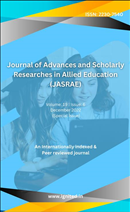Vulnerability Assessment: effective tool for landslide disaster management in Western Ghat of Maharashtra
Assessing Vulnerability and Planning for Landslide Disaster Management in Western Ghat of Maharashtra
Keywords:
Vulnerability Assessment, landslide disaster management, Western Ghat of Maharashtra, India, catastrophes, Himalayas, North eastern hill ranges, Western Ghats, Eastern Ghats, Nilgiris, Vindhyas, hydro-geological hazards, floods, meteorological conditions, steep slope, thick soil cover, slips, valleys, livelihood, environmental damages, natural resources, slope stability conditions, development activities, vulnerability in terms of physical, social and economical aspects, landslide hazard zonation map, preventive measures, degree of loss, landslide risk assessment, policy makers, implementation policiesAbstract
India has a sensational record of catastrophes. Largest parts of India, especially the Himalayas,the North eastern hill ranges, the Western Ghats, the Eastern Ghats , the Nilgiris, and the Vindhyas, affectdue to landslides, as one of the major hydro-geological hazards. Prone to frequent floods and extrememeteorological conditions, Western Ghat is prone to landslide with its steep slope and thick soil cover.Unlike other catastrophes such as droughts and floods, landslides may appear to be small, but the slipsalong the valleys can be more incurable and may take years to recover for the people from the region. Thelivelihood of thousands of people get devastated along with irreversible environmental damages due torapid erosion of natural resources of degradation of soil along the valleys. There is a requirement topropose the structures in the frames of environmental sustainability, economic feasibility and socialacceptability.It is imperative that slopes vulnerable to failure should be identified prior. In accordance with the slopestability conditions of hilly region, development activities may be planned. To access the vulnerability interms of physical, social and economical aspects, the landslide hazard zonation map can be used so as toadopt suitable preventive measures. For this with reference to the expected degree of loss due to landslide, landslide risk should be identified. The risk is determined by the product of the landslide hazard and thevulnerability. For a landslide risk assessment, data regarding the Landslide hazard and vulnerability areimportant. This is useful for planning appropriate defining strategic goals of Societal improvement itsenvironmental surroundings by helping the policy makers in making the implementation policies.Published
2022-12-01
How to Cite
[1]
“Vulnerability Assessment: effective tool for landslide disaster management in Western Ghat of Maharashtra: Assessing Vulnerability and Planning for Landslide Disaster Management in Western Ghat of Maharashtra”, JASRAE, vol. 19, no. 6, pp. 135–140, Dec. 2022, Accessed: Jul. 01, 2024. [Online]. Available: https://ignited.in/jasrae/article/view/14154
Issue
Section
Articles
How to Cite
[1]
“Vulnerability Assessment: effective tool for landslide disaster management in Western Ghat of Maharashtra: Assessing Vulnerability and Planning for Landslide Disaster Management in Western Ghat of Maharashtra”, JASRAE, vol. 19, no. 6, pp. 135–140, Dec. 2022, Accessed: Jul. 01, 2024. [Online]. Available: https://ignited.in/jasrae/article/view/14154








